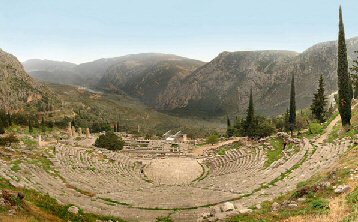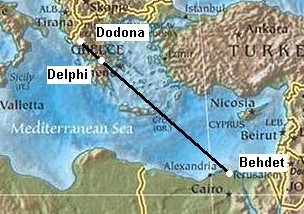|
Location: The foot of
Mount Parnassus, Grece. |
Grid Reference:
38� 37′ N,
23� 49' E. |
 Delphi:
(Earth Navel, Oracle Centre).
Delphi:
(Earth Navel, Oracle Centre).
 The
most famous oracle centre in the ancient world. The
most famous oracle centre in the ancient world.
The foundation of the oracle at Delphi extends back into prehistory.
While it was known as the greatest oracle in the world during the
Classic Greek period, it has a provenance that can be traced back
to a site of worship of the mother goddess Gaia.
The Oracles at Delphi were known as 'pythona', and were able to
successfully predict future events for over a thousand years.
The Latitude of Delphi (38�
37' N,) is almost exactly
3/7th of the distance from the Equator to the Pole.
The site of the
Delphine Oracle, arguably the most important oracle in the classic
world and sacred since prehistoric times
(1),
originally being a shrine to Gaia, a fact to which various authorities
testify (i.e. Aeschylus and Euripides).
Delphi is also
associated with the worship of Apollo (the sun god), who is said to
have killed the serpent Python at Delphi, essentially
supplanting one form of worship with another. The sites status as an
Earth Navel was recognised by Herodotus, who connected the oracle
centre at Delphi with the one at Karnak in Egypt, both sites at which Omphalos stones have been found.
...'Know
Thyself'...
(...Inscribed
over the entrance to the Delphic Shrine...)
The capacity for the
Pythae to predict the future successfully for over a thousand years.
'Geological studies
showed that Apollo's temple was built possibly upon two crossed seismogenous
and hydrophilous faults. Geochemical studies illustrate the existence of
vapours such as methane, ethane, ethylene and carbon dioxide eminating from
the faults
(1). The hallucinogenic effects of ethylene are known to medical science. It is suggested that the effects of ethelyne, the lack of oxygen
and/or the chewing of laurel may have been responsible for the Pythia's
hypnagogic state'.
(1)
The subsequent power to
prophesise is more difficult to explain, but it is remembered that an
association between shamanic prophetic states and the consumption of
hallucinogenic substances is well recorded.
(More about the role of drugs in Prehistory)
The apparitions which
appeared to protect the site against the Persians were described by Herodotus.
The Floating Spheres - Another phenomena, which is
not
exclusive to Delphi, is the recording
on a digital camera of some
floating spheres which are not associated with the known piezoelectric
phenomena or droplets of water or vapour's of steam and gasses.
(1) These
'floating spheres' were studied and presented scientifically by Ledwith and
Heinemann (2007).
The Foundation of Delphi:
Far above the Delphic shrine and
temples, and higher up Mount Parnassus is a large cave entrance. Within
this cave have been found offerings as old as 7,000 years old. These
include small incense and candle holders and jewellery, but more
importantly - over 25,000 knuckle bones of which 20% were inscribed with
names of gods and carved into dice (used for divination).
The foundation of the oracle of Delphi is described by three early
writers: The author of the Homeric Hymn to Apollo, Aeschylus
in the prologue to the Eumenides, and Euripides
in a chorus in the Iphigeneia in Tauris. All three versions
disagree with each other basically, but have been superficially combined in
the conventional version of late classical times." The Euripides
version reproduces in a sophisticated form the
primitive tradition which Aeschylus for his own purposes had been at pains
to contradict: the belief that Apollo came to Delphi as an invader and
appropriated for himself a previously existing oracle of
Earth. The slaying of the serpent is the act of conquest which secures
his possession; not as in the Homeric Hymn, a merely secondary work
of improvement on the site. Another difference is also noticeable. The
Homeric Hymn, as we saw, implied that the method of prophecy used there
was similar to that of Dodona:
both Aeschylus and Euripides, writing in the fifth century, attribute to
primeval times the same methods as used at Delphi in their own day. So much
is implied by their allusions to tripods and prophetic seats." ... "Another very archaic feature at Delphi also confirms the ancient
associations of the place with the Earth goddess. This was the Omphalos, an
egg-shaped stone which was situated in the innermost sanctuary of the temple
in historic times. Classical legend asserted that it marked the 'navel'
(Omphalos) or centre of the Earth and explained that this spot was
determined by Zeus
who had released two eagles to fly from opposite sides of the earth and that
they had met exactly over this place... So although Delphi
was originally devoted to the worship of the Earth goddess whom the Greeks
called Ge, or
Gaia, It is
sufficient interpret him as the Homeric Hymn represents
him -- as a northern intruder -- and his arrival must have occurred in the dark
interval between Mycenaean and Hellenic times. His conflict with Ge for the
possession of the cult site was represented under the legend of his slaying
the serpent."
The Geodetic nature
of Delphi - The foundation of Delphi and its oracle
took place before the times of recorded history. In relation to this, it is
interesting to note that the origin of Delphi is associated with the myth of
Zeus releasing two doves simultaneously from the eastern and western
'edges' of the earth, reflecting a knowledge of earth's sphericity.
Delphi is located almost exactly 3/7th's
of the distance from the Equator to the Pole, Karnak in Egypt is 2/7th's and
Silbury Hill is 4/7th's.
(90/7 = 12.857 Which
translates to 12 � 51' 25")
Karnak -
25� 43' 0" N (90/7 x2 = 25.714) which translates as 25 �
42' 05".
Delphi -
38� 37' N (90/7 x3 = 38.57) which translates to 38� 34' 03".
Silbury
Hill -
51� 24� 50�� N (90/7 x4 = 51.428) which translates to 51� 25' 40".
Delphi also lies along the same alignment formed by connecting
Dodona to Behdet in Egypt (which was the
geodetic capital of Northern Egypt before 3,000 BC according to Stecchini),
and which sits on the same longitude as Thebes and the same Latitude as
Alexandria. Herodotus connected Delphi with Thebes
(Karnak) in his narration.
(More about
Egyptian Geodesy)

Dodona, Delphi and
Behdet are all separated by units of whole degrees of Latitude.
As proof of Delphi's
recognition of its coordinating role in the positioning of isolated temples
all over Greece we have Plato's and Aristotle's statements which indicate
that the 'Delphic priests were responsible for placing temples and shrines
in accordance with a
Sacred Law'.
(1)
Delphi is associated
with two points in Asia and Africa. These points form an inverted giant
Isosceles triangle. Its corners are composed from Navels. Its top corner is
based on a site in Africa which is called Oasis Siwa, and the third corner
is in at Sardeis in Anatolia. The Hellenic myths describe three navels at
each particular corner with Heraclese, the
collective subconscious
of prehistoric Greece being represented at each Navel.
(1)
(More about Earth Navels)
(Other Greek locations)
(Divination)
|
 The
most famous oracle centre in the ancient world.
The
most famous oracle centre in the ancient world.